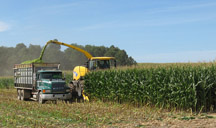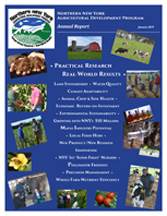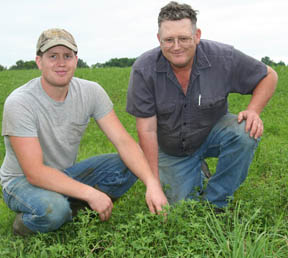 Lowville, NY; February 15, 2019. The steadily increasing presence of Western Bean Cutworm in New York State and the pest’s feeding damage to corn silage crops raised a concern for dairy farmers. Does crop damage by the insect create the opportunity for mycotoxins to form in the silage, posing a risk to livestock health, crop yield, and farm economics?
Lowville, NY; February 15, 2019. The steadily increasing presence of Western Bean Cutworm in New York State and the pest’s feeding damage to corn silage crops raised a concern for dairy farmers. Does crop damage by the insect create the opportunity for mycotoxins to form in the silage, posing a risk to livestock health, crop yield, and farm economics?
Two years of research funded by the farmer-driven Northern New York Agricultural Development Program and conducted by the Cornell CALS PRO-DAIRY Program helps put that concern at ease.
“Prior to this study in Northern New York, no clear relationship had been proved or disproved by any other research. Over the course of this two-year study in Northern New York, we did not see any evidence that Western Bean Cutworm damage is an added risk factor for mycotoxin development in corn silage crops,” said project leader and Cornell CALS PRO-DAIRY Dairy Forage Specialist Joe Lawrence.
The research data is detailed in the Understanding the Interaction of Western Bean Cutworm Damage and Mycotoxin Risk in Corn Silage report posted under the Field Crops Research tab on the Northern New York Agricultural Development Program website at www.nnyagdev.org.
Using the Corn Silage Hybrid Evaluation Program, a collaboration by Cornell University and the University of Vermont, as a testing platform, Lawrence sampled corn from 49 silage hybrids planted in St. Lawrence County in 2017 and from 77 silage hybrids planted in St. Lawrence and Essex counties in Northern New York in 2018.
“Results from the trials in Northern New York revealed large differences in the number of corn hybrids damaged by Western Bean Cutworm, however, despite the damage present, surprisingly few hybrids tested positive for measurable mycotoxins,” Lawrence noted.
Additionally, Cornell Cooperative Extension crops specialists and agribusiness professionals identified fields with Western Bean Cutworm damage across Northern New York and collected forage samples at corn silage harvest. Although significant damage was observed, only two of six sample sets showed any mycotoxins and toxin levels were low.
Best practices for corn production, silage management, and storage can greatly reduce the risk of mycotoxin development, but climate-stressed and pest-damaged corn can be more susceptible to mold that can spawn a variety of mycotoxins. A number of mold species may develop on corn ears, but relatively few produce mycotoxins. The most prevalent species of mycotoxin-producing mold identified each year in New York is one that favors wet weather conditions.
Lawrence advises growers to remain vigilant in their crop scouting for Western Bean Cutworm and to continue to follow the best management practices that reduce the risk for mold, particularly in years where weather conditions are more conducive to mold development.
“It is important to note that the results of this specific research do not reflect what may occur in corn harvested for grain as the time between silage harvest and grain harvest offers additional exposure time for pest or disease damage to occur,” Lawrence added.
For growers wondering how Western Bean Cutworm impacts crop economics, Lawrence offers data from the 2018 NNYADP trials that showed despite Western Bean Cutworm damage to corn kernels, in some plots with up to 60 percent of ears with some level of damage, the pest’s feeding did not correlate to any negative impact on silage yield or forage starch content.
Funding for the Northern New York Agricultural Development Program is supported by the New York State Senate and administered by the New York State Department of Agriculture and Markets.
———————
Understanding the Interaction of Western Bean Cutworm Damage and Mycotoxin Risk in Corn Silage Report
YouTube: Corn Silage Hybrid Evaluation Program 2018 Results (statewide) presentation by Joe Lawrence


 Other NNYADP research into the variable climate, environmental and farm management factors related to heat stress on dairy calves and cows is providing the basis for adapting best care practices for application farm-by-farm and by season. Learn more on the Northern New York Agricultural Development Program website at
Other NNYADP research into the variable climate, environmental and farm management factors related to heat stress on dairy calves and cows is providing the basis for adapting best care practices for application farm-by-farm and by season. Learn more on the Northern New York Agricultural Development Program website at  Northern N.Y.; January 9, 2019. The farmer-driven Northern New York Agricultural Development Program has posted its annual report at
Northern N.Y.; January 9, 2019. The farmer-driven Northern New York Agricultural Development Program has posted its annual report at  The NNYADP has commissioned a first-of-its-kind project for New York State. Miner Institute has begun evaluating how the use of tile drainage interacts with soil, crops, and water resources in a project located along Lake Champlain. The work includes a comparison of water quality and crop yield and quality from tiled and naturally draining fields.
The NNYADP has commissioned a first-of-its-kind project for New York State. Miner Institute has begun evaluating how the use of tile drainage interacts with soil, crops, and water resources in a project located along Lake Champlain. The work includes a comparison of water quality and crop yield and quality from tiled and naturally draining fields. As evidence of the combined long-term commitment by New York State and the NNYADP to funding and finding a solution to the devastating alfalfa snout beetle, the annual report notes that the biocontrol application developed in NNY has not only restored alfalfa production regionally but is now finding use to manage pests in other crops across New York State and elsewhere in the U.S.
As evidence of the combined long-term commitment by New York State and the NNYADP to funding and finding a solution to the devastating alfalfa snout beetle, the annual report notes that the biocontrol application developed in NNY has not only restored alfalfa production regionally but is now finding use to manage pests in other crops across New York State and elsewhere in the U.S.